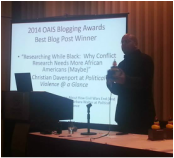Now, one of the more interesting findings of this paper was that blacks and whites did not perceive the same tactics as being equally lethal/severe. In fact, whites were more willing to give police a pass viewing certain tactics as being less problematic whereas blacks were more willing to give protestors a pass viewing certain tactics as being less problematic. Essentially, this means that what we see taking place out in the streets will not generally be viewed in similar manners across distinct audiences and that our perceptions will likely lead to distinct actions in the aftermath of relevant activities. It's not all bleak however. What is interesting here is that it may be the case that when especially disproportionate activities are undertaken, we might see a convergence of opinion and in these moments we might actually find people coming together. The latter insight was beyond the study mentioned but it definitely seems possible thus providing a little possibility of peaceful engagement amidst the dark cloud of future contention.
|
David Armstrong, Thomas Zeitzoff and myself once wrote a paper about how different people perceived the severity of different tactics that could be selected by protestors and police. In this work, we used a survey to identify what were perceived to be proportionate tactics as well as those which were perceived to be disproportionate. The idea was that those which were believed to be comparable in terms of their degree of lethality/severity would not raise much of an eyebrow but those where either the police or protestors used behavior that was deemed to be non-comparable/disproportionate would piss people off - prompting perceptions of illegitimacy on behalf of the disproportionate actor and a willingness to support the actor viewed as being poorly treated. Marching in the streets being met with pepper spray and tear gas is clearly in the zone of disproportionate response. Looking at the current wave of protests and protest-policing moving across the US we can see all types of combinations of protestor and police action. I provide the chart above to help you better understand what choices are being made by the actors involved as well as how different combinations of protestor and police tactical choices will likely influence subsequent attitudes as well as behavior.
Now, one of the more interesting findings of this paper was that blacks and whites did not perceive the same tactics as being equally lethal/severe. In fact, whites were more willing to give police a pass viewing certain tactics as being less problematic whereas blacks were more willing to give protestors a pass viewing certain tactics as being less problematic. Essentially, this means that what we see taking place out in the streets will not generally be viewed in similar manners across distinct audiences and that our perceptions will likely lead to distinct actions in the aftermath of relevant activities. It's not all bleak however. What is interesting here is that it may be the case that when especially disproportionate activities are undertaken, we might see a convergence of opinion and in these moments we might actually find people coming together. The latter insight was beyond the study mentioned but it definitely seems possible thus providing a little possibility of peaceful engagement amidst the dark cloud of future contention.
0 Comments
|
Analog - The Anti-BlogBy "Analog" I am referring to the adjective (i.e., relating to or using signals or information represented by a continuously variable physical quantity such as spatial position or voltage) and not the noun (i.e., a person or thing seen as comparable to another) for I wished to give voice to my thoughts which have come to me in a more or less continuous manner but which do so in a way that is not consistent in content or form. Thus you will see short stories, brief thoughts, haikus, low-kus and even a political cartoon or two. Archives
November 2023
Categories
All
|



 RSS Feed
RSS Feed
